2. Parts of Chinatown today were once occupied by the notoriously dangerous Five Points neighborhood

During the 19th century, the Five Points neighborhood in Lower Manhattan was the most dangerous area of the city, gaining international notoriety for being a densely populated, disease-ridden, and crime-infested slum. The neighborhood received its name from the intersection of Orange, Anthony, and Cross Streets, which created five corners or “points.” Though this intersection no longer exists, the closest one to where it once was is where Columbus Park meets Worth and Mulberry Streets.
Five Points was built on top of the former Collect Pond, which had been cheaply filled in 1812. As a result, the brick and wood houses built on the pond were unstable and began to sink, creating a neighborhood that only attracted those who could not afford to live elsewhere. The area became a hotspot for crime for the remainder of the century — with its Old Brewery known as the Den of Thieves.
Throughout the 20th century, the neighborhood was gradually redeveloped. Today, the area that was once Five Points is occupied by the Civic Center to the west and south and Chinatown to the east and north. Still, some remnants of the neighborhood exist to this day, including Columbus Park, which was designed by Calvert Vaux, co-creator of Central and Prospect Parks. In Chinatown, visitors can also walk down Mosco Street, which during the mid-1880s was known as Cross Street.





